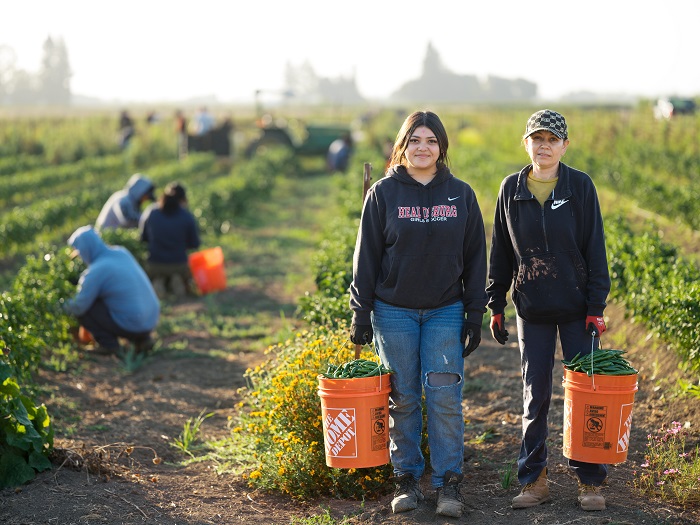The People’s Garden – Farmworker families grow food for themselves and those in need.
Photos by Paige Green
Pants freshly stained with grape juice after a long night harvesting a nearby vineyard, a worker arrives to a farm just outside Healdsburg. After an exhausting shift, he should be heading straight for a shaded hammock for some much-deserved rest. Instead, he walks between towering banana plants and a greenhouse strung with drying hibiscus flowers into a field where he resumes working. Here, though, his harvest isn’t destined for a bottle of pinot noir he can’t afford; instead, the tomatoes he’s volunteered to help load up will go to the Healdsburg Food Pantry so that families like his can fill their kitchens with healthy, fresh foods that remind them of home.
It’s for farmworkers like this, says Ezequiel “Zeke” Guzman, that he founded Jardín del Pueblo: The People’s Garden.
On a warm September morning when I arrive to meet him, Zeke is troubleshooting a malfunctioning compost spreader. He and a few men are preparing a few acres of soil so they can get their fall crops planted in time. Finally, the machine starts working again, and Zeke returns to showing me around: marigolds interspersed with purslane, nopales setting magenta fruit, and a tunnel of chayote fruit which we stroll beneath while he explains how the idea of this project first came to him.
After decades as a housing and farmworker advocate, Zeke found himself enjoying retirement by volunteering at the Redwood Empire Food Bank. Of the families who typically arrive there, many are from Latin America and work in local agriculture. “I just don’t understand how the people who feed us,” he says, “can’t afford to feed themselves.” He’s referring, of course, to the strange irony that here in California, communities with the highest agricultural GDP also have the highest rates of food stamp recipients.
But one day, he overheard the families arriving at the food bank, though grateful for the food, lamenting how they missed the farms where they grew up and the flavors of their homelands: fresh serranos, poblanos, cilantro, Mexican zucchini, and varieties of tomatoes more common south of the border.
Zeke understood in that moment that the missing link wasn’t just a more culturally appropriate variety at the food bank; these farmworkers, despite the hours they spend working on other people’s land, also longed for a deeper connection to soil and with one another.
Pausing beside an old piece of wood that I’d have surely overlooked had he not pointed it out, Zeke tells me how his father, born in rural Michoacán, was one of 18 children. “People always ask how my family was able to sustain that. The answer,” he says, gesturing back towards that wooden antique hauled back from his childhood farmstead, “is with an ox and a plow. This very plow. Everyone was expected to pitch in. It allowed us to survive but also gave us a sense of pride.”
This is the difference between food access, which merely provides sustenance without agency, and food sovereignty, which is a community’s right to control and define their own food and agricultural systems.
It was that same sense of pride that Zeke hoped to share with others when, in 2022, he invited eight farmworker families onto his five-acre property to grow food for themselves as well as others in need. They planted nearly 1,000 plants that first season, harvesting around 8,000 lbs. of food.
The following season, not only did they increase production, but as word spread of their endeavor, their community grew too, as more volunteers began arriving, ready to roll up their sleeves. “Suddenly we had 50 families involved,” he says. “It was chaotic at first, but beautiful too.”
Once they maxed out Zeke’s small property, his neighbor, who had been watching with amazement over their fence as the project blossomed, offered a parcel of his own land for them to expand. Then a friend near Santa Rosa volunteered his acreage to provide the same opportunity to a new community. Then came a group called the Sonoma Valley Collaborative that wanted to bring that same energy to their community. And up north, Geyserville High School jumped on board, opening up Jardín de Esperanza (Garden of Hope) where students and their families worked together.
While farmworkers remain at the heart of this effort, other community members, feeling inspired, have gotten involved, too. Local businesses donated equipment, including a brand-new electric tractor. The local Rotary also pitched in to support. Eventually, the Sonoma County Community Foundation caught wind of their work and donated funds so that Zeke can now hire high schoolers from farmworker families to help during summer break.
As we finish the farm tour and continue our chat in the shade of a big tree, Zeke points out a young man who’s lately taken an interest in the farm machinery and is now entertaining a career in metal work or mechanics. Among Zeke’s many dreams for this project—new infrastructure, more gardens elsewhere in the county, a mobile produce stand—he’s exploring the prospect of an incubator farm as well. He envisions a place where farmworkers not only come to volunteer but find the resources and education to start their own farms and other entrepreneurial endeavors.
Despite the continued growth and optimism of Jardín del Pueblo, the past year has proven one of the most challenging. Recently, Zeke explains, during a distribution day at the Geyserville Food Bank, rumors of law enforcement in unmarked cars swept through town, igniting a panic. Traumatized by scenes from across the country of masked ICE agents ignoring due process, kidnapping bystanders from the street and throwing them into vans, no one showed up that day to pick up food. Volunteers from Jardín del Pueblo had to head back with boxes still full of produce that never made it to those in need.
As the political climate in the U.S. grows more hostile to immigrants—who comprise upwards of 90 percent of California’s agricultural workforce—Zeke is watching the community for whom he’s built Jardín del Pueblo either hide in the shadows or disappear. Despite this, he takes solace knowing that what he and his community are building together here can also be a place of renewal, solidarity, and hope.

“Because we understand hunger. And we see that need. It makes me happy to be here.” – Jardín del Pueblo volunteer
As my conversation with Zeke wraps up, I notice a volunteer approaching. After a few hours spent harvesting, he takes a rest in the shade of the same tree under which we sit. “How is it possible,” I ask Zeke in a whisper, “that a farmworker can finish up an entire shift in a vineyard, then come straight here, roll up their sleeves, and go back to work?” To my surprise, Zeke turns around and shouts, translating my question into Spanish.
Wiping the sweat from his brow, the man takes hardly a second to think before replying, as Zeke translates his answer back into English for me: “Because we understand hunger. And we see the need. It makes me happy to be here.”
On my way out, just as an early autumn heat wave takes hold, I slow beside several long rows of peppers. On a small sign, I find the words: “Nuestro Jardín es Tu Jardín.” Our garden is your garden. In times like these, food alone isn’t enough; here, those who keep America fed find belonging, co-creation, a chance to give back, and a place to call their own.



